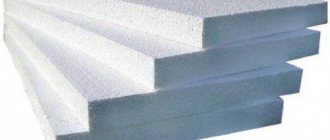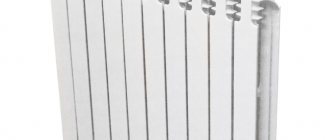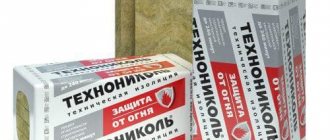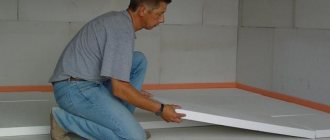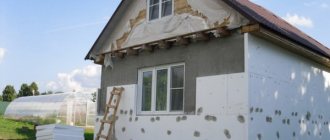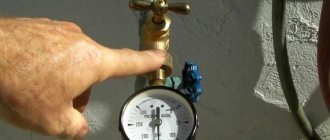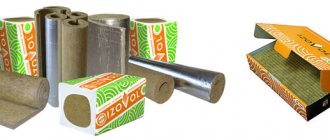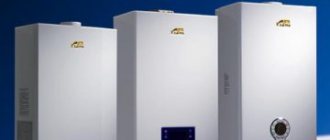Today in this article we will look at the current issue in our time about the service life of insulation in the table. As a rule, houses, buildings and other structures are insulated for a long time, so materials are needed as reliable and of the highest quality as possible . Many people believe that various types of insulation do not last more than 30 years. Taking into account the fact that the wall that is being insulated lasts about 100 years, we come to the conclusion that during this time the procedure must be done 2-3 times. If you calculate the cost of such an update, it may not please you.
Service life of insulation, which insulation to prefer
Many competent sources claim that the service life of mineral wool and expanded polystyrene is 25 - 35 years. At the same time, a wall that is insulated with these insulation materials made of brick or concrete lasts more than 100 years. Therefore, the wall insulation must be changed at least 3 times during its service life. Was the insulation chosen correctly, due to which it is necessary to carry out a major overhaul of the building in such a short time?
How long do inexpensive insulation materials last?
The main question is where does the 30-year service life of cheap insulation come from? Today, some mineral wool manufacturers indicate in the technical specifications for individual brands of their products that their service life is 50 years.
Moreover, this figure is not explained in any way; there is only a footnote that today there is no standard for determining the shelf life of insulation materials.
Scientific articles regarding artificial insulation indicate that insulation containing artificial organic substances can last no more than 35 years.
During this period, organic matter is destroyed, the substance ages, and the insulation “cakes” or “dries out.” The main thing is that as a result of this, the insulation loses more than 1/3 of its heat-saving ability. Consequently, mineral wool or expanded polystyrene insulation must be completely replaced within a period of up to 35 years.
How is it in Europe?
Now in European countries, according to legislation, an energy audit of every new home, including private ones, must be carried out after its construction is completed. Based on the results, an energy certificate is issued for the building.
Proven energy savings have a very significant impact on property values in Europe.
Repeated energy audits should be carried out after 25-30 years, after a period equal to the service life of conventional insulation materials. The next one will follow after approximately the same period of time.
As a result, it becomes clear how much the building has lost its heat-saving properties, which enclosing structures and how much they have reduced the resistance to heat transfer, where it is necessary to change the insulating material or carry out other repairs.
Like we have
In our country, such studies are not mandatory, although they are recommended by regulations. As a result, in most cases they are not carried out, and it is not possible to find out exactly the real service life of insulation materials by examining them after many years. It remains to use data coming from abroad, according to which the indicated figures were taken.
It is advisable to carry out energy audits of new buildings and periodic checks of the heat transfer resistance of building envelopes within the time limits recommended by regulations. Then it will be possible to monitor changes in the insulation of the building and carry out the necessary repairs in a timely manner.
When to change insulation
An exact answer to when to change the insulation can only be given by a special examination of the heat-saving properties of the building (energy audit). But since over the past 20-25 years, when the use of insulation materials such as foam plastic and mineral wool began, we have not carried out such examinations, all that remains for subsequent checks is to compare the results obtained with theoretical calculated values. But there are no reliable statistics on the failure of insulation materials.
Accordingly, it is necessary to use recommendations for replacing non-mineral insulation materials within the time limits specified above.
Experts agree that the service life of existing insulation materials with organic components is several times less than that of the enclosing structures that are insulated with them. The use of such insulation materials entails premature major repairs of buildings. How to avoid this?
Dense mineral wool and aerated concrete with a long service life
There is a unanimous opinion that denser mineral wools last longer. Partly because the quality of workmanship is ensured by renowned manufacturers, and partly because denser mineral wool contains less binding resins (in total, mineral wool contains from 3 to 10% organic binders). Denser (more than 80 kg/m3) mineral wool samples last longer.
A successful replacement for mineral wool is now aerated concrete made in autoclaves with a density of not much more than 100 kg/m3. This material has a thermal conductivity coefficient comparable to organic insulation - 0.5 - 0.8 m W/mS.
But most importantly, this is a completely mineral compound, which is essentially a foamed stone, so its service life (in the absence of excessive moisture) is comparable to that of heavy building materials - brick, dense concrete.
The use of insulation without organic matter will eliminate many problems in the future, especially when it comes to insulating multi-layer walls (as walls lined with clinker bricks are insulated),
Low-density aerated concrete is a vapor-permeable insulation material, its use is similar to the use of mineral wool.
Eternal foam glass
Another well-known organic-free insulation is foam glass, which has a service life of more than a hundred years. This insulation has been used for a long time (in particular in the secret weapons sector), it has less heat-saving capabilities compared to effective insulation by about 1.5 times, it does not allow water vapor to pass through it and does not accumulate water.
But its distribution is limited due to the increased price, although it is popular for insulating expensive houses.
Among foam plastics, extruded polystyrene foam stands out for its predicted resistance to harmful factors and durability. It does not accumulate water, does not allow steam to pass through it (similar to foam glass), has a denser structure and has twice the specific gravity compared to foam plastics (over 35 kg/m3).
But due to the higher price, it is used mainly in difficult conditions, in soils, for foundations, plinths, basements. In any case, among plastics it is more recommended for use in terms of “survivability” than other plastics.
As you can see, to insulate the building envelope, it is better to choose insulation with a minimum of organic substances or without them at all.
Details
Advantages of frame houses
Among the advantages of houses built using frame technology are the following:
Extremely high alignment speed.- Ease of construction (frame-type houses can be assembled with your own hands, because each house kit comes with detailed instructions for structural assembly).
- Shrinkage of such a structure takes a maximum of 5 months (for comparison, let’s say that shrinkage of a panel or brick house takes at least 1.5 years, and for buildings made of rounded logs, 1 year).
- Finishing work, according to the shrinkage technology of frame houses, can begin after 5 months (this work should not be carried out before the house has completed shrinkage).
- Monetary savings (all frame houses will be at least 2/3 cheaper than houses with the same area, built from other materials).
- Structural lightness, which makes it possible to build lightweight foundations (the load will be only 750 kg per cubic meter, which makes it possible to build either a monolithic strip, or columnar, or shallow foundation).
- Relatively high strength (the house can withstand an earthquake of 7 points on the Richter scale, and this is a significant indicator).
Below is a table of aging of a residential building.
Disadvantages of frames
Although the service life of a frame house is excellent, such a structure has certain disadvantages:
- There is no possibility of redevelopment (this applies only to panel factory houses, but redevelopment can be done in frame houses).
- If you take a panel house, then the number of floors will be limited (frame ones can also be two-story, but it is unlikely that it will be possible to build a second floor in a panel house).
- House walls have very high thermal conductivity (this refers to both frame houses and panel houses), although this minus can be easily offset by high-quality modern insulating materials.
- Frames have terrible impact, structural and airborne noise and sound insulation (interestingly, in construction noise and sound are similar, but they are still different phenomena by definition).
- Inside the insulating material of a frame house, if there is not the highest quality hydro- and steam insulation, various insects may appear (this is a noticeable drawback, because it will be very difficult to eradicate them from the inner layer of the frame wall).
The load on the base that a frame house will provide will be only 750 kg per cubic meter.
How mineral wool is made, its properties
Mineral wool is formed by melting rocks and passing them through the finest dies. The resulting fibers are immediately cooled at the exit from the furnace and wound onto spools. Electrical insulating woven materials are produced from stone fibers, but a certain part of them (usually discards) is cut from the spools and ends up in scutching machines, where wool is produced.
Then the resulting wool is fed under presses, where sheets are formed, rolled into rolls (low density) and slabs (mineral wool of medium and high density).
In its essence and chemical composition, fiber wool remains the same stone (mining material), which is not afraid of dampness, mold, or any other fungi. This is a chemically neutral insulation that behaves calmly when the acid-base environment changes and does not react in any way to the appearance of, for example, rust. Mineral wool is not afraid of temperature changes, it is not prone to fire, and does not conduct electric current.
Rating of the best sofa manufacturers
| Nomination | place | factory | rating |
| The best factories of inexpensive sofas | 1 | 4.8 | |
| 2 | 4.7 | ||
| 3 | 4.6 | ||
| 4 | 4.5 | ||
| The best sofa factories in the middle and premium price segments | 1 | 4.9 | |
| 2 | 4.9 | ||
| 3 | 4.8 | ||
| 4 | 4.7 | ||
| 5 | 4.7 | ||
| 6 | 4.6 |
Where is mineral wool used?
In general, mineral wool is an ideal insulation material that is used for thermal insulation of heating pipelines, water pipelines, and industrial boilers at thermal power plants.
In recent decades, mineral wool has been increasingly used to insulate walls in house construction. If all heat and vapor barrier work is carried out correctly, mineral wool insulation will retain heat for as many years as the walls last. The manufacturer names the service life of mineral wool insulation as 50 years. But in fact, if installation work is carried out correctly, it will last much longer.
Installation methods
Mineral wool slabs are installed in two ways: dry and wet . The first involves laying slabs in the gap between the wall and the sheathing. For this, a wooden or metal frame is created. The insulation is laid in the spaces between the profiles. The wet method is gluing slabs onto the wall surface, followed by applying a primer and mesh reinforcement. Installation of mineral wool cylinders is carried out using self-adhesive tape or thin wire.
vote
Article rating
What factors destroy mineral wool?
At industrial facilities, even during major repairs, cotton wool cannot be replaced, because the material itself as a whole does not deteriorate, break down or decompose. Breakdowns can occur when steam under pressure forms a hole in the pipe (fistula) and, escaping, sweeps away the insulation. During insulation work, the old insulation is not removed.
Mineral wool insulation is able to withstand a new operational period until the next major overhaul, so it is reused. New material is applied where it has become smaller for various reasons. Only those sections of the insulating layer that, being open, become clogged with dust, dirt and turn to stone, must be replaced. Thus, the first enemy of mineral wool is dust and dirt.
Mineral wool: main characteristics
Among the wide variety of modern thermal insulation materials, the undoubted leader is held by mineral wool or the more popular name - isover.
Scheme of roof insulation with mineral wool.
It is difficult to imagine any construction work now without the use of this material. Mineral wool has long won the first position in construction from foam plastic and other conventional insulation materials. Due to its plasticity and softness, this heat and sound insulation insulation is used in almost all areas of construction, insulation and insulation. It is used to insulate and insulate pipes, walls, floors and ceilings of houses from the outside and inside. In addition to its heat-retaining properties, this material also has good sound insulation. Mineral wool is a fibrous thermal insulation material, which consists of mineral fibers (silicate rock melts) bound with synthetic resins. The name of this insulation characterizes its similarity to ordinary cotton wool in appearance, softness and structure. The composition and properties of mineral wool resemble asbestos fiber. Due to its increased resistance to chemicals and high temperatures, isover has an extremely long service life, which makes it the most preferred heat and sound insulation material in modern construction.
Environmental friendliness and safety
Scheme for insulating facades with mineral wool.
But from the point of view of environmental friendliness and safety in the use of mineral wool, disputes do not subside, and the environmental friendliness of mineral wool insulation raises a number of complaints, and its safety for health is subject to doubt. The fact is that one of the mineral fiber fractions in cotton wool has carcinogenic properties. In addition, the synthetic binder resin used in production releases formaldehyde, which is known to be extremely harmful and toxic.
Despite these undoubted signs of harmfulness, there are a number of rehabilitative properties that significantly increase the environmental friendliness of this insulation. Mainly large fibers have carcinogenic properties, and due to the fact that the composition of mineral wool mainly consists of fine-fiber compounds, the likelihood of harmful effects on the human body is minimized if the technical and sanitary standards of construction and installation are observed.
Basic information about the most popular insulation for those who are just thinking about choosing insulation.
The article was prepared with the participation of specialists from the ROCKWOOL company.
Modern construction cannot be imagined without the use of various thermal insulation materials to minimize heat loss. In an energy-efficient house, there are no crazy energy bills even with a large area, since only the premises are heated, and not the street. One of the most popular thermal insulation materials is stone wool, used both on an industrial scale and throughout the private sector. And although this insulation is perhaps the most common, there is still a lot of speculation around it, and manufacturers endlessly face the same questions. In this article, with the help of ROCKWOOL specialists, we will look at the main characteristics of stone wool:
- Raw material base, production technology, release form.
- Scope of application.
- Technical and operational characteristics.
- Answers to questions from forum members
Mineral wool service life
Scheme of wall insulation with mineral wool.
The thermal insulation and noise reduction advantages of this material are beyond doubt. What is the service life of mineral wool? Is its use ultimately beneficial, and how susceptible is the isover to wear? What differences exist in these characteristics depending on the fiber composition?
So, the service life of this insulation declared by the manufacturers is about 50 years. But this indicator is not considered indisputable and has a number of technical nuances. Various raw materials are used to make insulation, which affects the quality and durability. Today there are two main types of mineral wool.
The first type, the highest quality, is made from volcanic mountain rocks, basaltic lava or basalt stone. This kind of mineral wool is called stone, it costs an order of magnitude more, but its technical characteristics and service life are much higher than that of another type - slag.
Slag insulation is made from slag waste from the metallurgical blast furnace industry. Such material has a low price, does not last long, and is also subject to deformation, wear and does not tolerate temperature changes well. But nevertheless, this insulation finds its application in the insulation of non-permanent temporary buildings, sheds, and warehouses.
For capital construction and insulation of residential premises or to increase fire safety, it is recommended to use more expensive stone wool, which has a very low degree of ignition and a higher degree of thermal insulation and noise reduction.
Mineral wool has a passive chemical environment, which eliminates the occurrence of corrosion on adjacent metal pipes and fittings. In addition, isovers are resistant to temperature deformation, have very little shrinkage, and over all the years of operation, mineral wool insulation practically does not change its size, thickness and position. Naturally, this property significantly affects the service life.
Materials for insulating walls and facades of apartment buildings and private houses - TECHNONICOL
The review contains all materials for thermal insulation of facades and walls that are suitable for private construction and renovation. You will learn what different types of insulation are intended for, what their main properties are, where and how they can be installed. You will be able to choose a material that is ideal for thermal insulation of the walls of your home and will help you avoid mistakes or unnecessary expenses.
TECHNOBLOCK stone wool slabs
Universal material for heat and sound insulation.
Application area:
TECHNOBLOCK is recommended for use in layered masonry (wall-insulation-cladding), including for thermal insulation of building facades with various types of finishing. It is also possible to install slabs as the first internal thermal insulation layer in curtain air-permeable facades with a two-layer insulation scheme.
10 cm of TECHNOBLOCK stone wool is equal in heat-saving capacity to 38 cm of timber or 140 cm of clay brick masonry.
Material Features:
- does not shrink;
- material service life 50 years;
- reduces heating costs;
- resistant to rodents and mold;
Material characteristics:
- Plate thickness from 50 to 200 mm, density 40-70 kg/m3.
- Water absorption no more than 1.5%.
- Thermal conductivity coefficient ƛ25 from 0.036 to 0.037 W/m*K.
- The slabs are easy to install - they can be cut with available tools (a knife or a saw with fine teeth) and adjusted to the desired size.
Important!
All mineral wool is treated with water-repellent additives, which gives the insulation additional water-repellent properties.
Rocklight mineral wool slabs
Thermal and sound insulating slabs made of stone wool based on basalt rocks are suitable for low-rise and cottage construction.
Application area:
ROCLITE slabs are used as heat and sound insulation in attics, frame walls and walls to be finished with siding.
ROCLITE, when used for thermal insulation, provides not only reliable insulation, but also environmental comfort.
Material Features:
- reduces heating costs;
- service life 50 years;
- not susceptible to rodents and mold.
Material characteristics:
- Plate thickness from 50 to 150 mm, density 30-40 kg/m3;
- Water absorption no more than 2%;
- Thermal conductivity coefficient ƛ25 = 0.039 W/m*K;
- The material is not flammable - the melting point of the fibers exceeds 1000° C;
- Not susceptible to rodents or mold.
The material has a high sound absorption coefficient, which allows it to be used in floors, ceilings and various partitions.
Mineral wool slabs TECHNOFAS COTTAGE
Heat and sound insulating slabs made of stone wool based on basalt rocks.
Application area:
designed for insulating walls of low-rise buildings (height up to 10 m). Using the material, you can insulate internal walls on glazed loggias and balconies, along flights of stairs and landings of multi-story buildings.
Material characteristics:
- The thickness of the slabs is from 50 to 200 mm, which will maximize the usable space of the interior;
- They do not absorb moisture - the water absorption of the slabs is no more than 1.5%;
- Thermal conductivity coefficient ƛ25 = 0.038 W/m*K;
- Non-flammable material - safe for indoor insulation;
- Environmentally friendly - does not affect human and animal health.
The service life of mineral wool is comparable to the service life of a building and is 50 years. At the same time, during the entire period of operation the material does not lose its properties.
Thermal insulation boards LOGICPIR Wall
This is a new generation of environmentally friendly and healthy insulation materials.
Advantages and disadvantages in construction
Scheme of mineral wool production.
Separately, mention should be made of the purely technical disadvantages and advantages of this material when used in construction. Isover today is supplied in slabs and rolls. The material comes in rolls, softer and more flexible, which can be cut well with ordinary scissors and can be easily placed under the sheathing. For larger and more serious construction, mineral wool slabs are used. They are denser, cut with a knife and secured with special profiles or nails.
The main disadvantage when planning insulation is that mineral wool, due to its vapor permeability, directly depends on the finishing layer. And the denser it is, the more moisture the isover fibers absorb. This will not cause any harm to the insulation itself, but the thermal insulation properties will be significantly reduced. Due to its high hydrophilicity (ability to absorb water), when used in façade insulation, mineral wool is recommended to be pre-impregnated with water-repellent compounds, which will impart water-repellent properties to the insulation. In addition, a thermal insulation project should initially be drawn up taking into account all these characteristics.
Experiment results
Experts conducted a study to find out how mineral wool behaves under unfavorable conditions. During the experiment, mineral wool samples were left outdoors in the snow and rain, as well as on the facade of a house in the sun.
Material exposed to ultraviolet light appears to tan and turns dark brown. Also, the top layer of insulation is made more loose. This may in the future threaten to cause the plaster to fall behind it.
A sample of mineral wool that was stored outside became saturated with water and became heavier. It is clear that there is no need to talk about heat-saving properties here. They just disappeared. Covering a house with such insulation is like sleeping under a wet blanket in the cold.
Experts note that violation of storage conditions also destroys lightweight insulating materials (low density). It leads to the formation of cold bridges in them. Lightweight materials are more porous, therefore, they absorb moisture much more and faster.
This, of course, does not mean that the use of mineral wool insulation should be abandoned. They have undeniable advantages, but, like any other material, they need to comply with storage rules. You can’t keep mineral wool outside, either in a warehouse or at home.
Which mineral wool to choose for insulation
To insulate your home, you have many options at your disposal. You will be guided by different considerations when you start choosing thermal insulation for your foundation, floor, walls or roof: each case will have its own requirements for the material. Here we will look at two types of universal traditional material - mineral wool. You'll learn how these options differ from each other and can determine which of the two options is better for a specific structure or area of your home.
Requirements for insulation
Requirements for thermal insulation are directly indicated or follow from building codes and regulations. The main, but far from the only document is SNiP 02/23/2003 “Thermal protection of buildings”. With the help of SNiP, acceptable materials, the thickness of the insulating layer, requirements for how the material absorbs water and how air and vapor permeable it is are determined. In general, insulation for any area of the house should be assessed according to the following parameters:
- Thermal conductivity : the inert gas krypton has the lowest parameter value in nature. Modern insulation materials made from innovative materials have thermal conductivity in the range of 0.032 – 0.045 W/(m*K). In any case, the value indicated on the packaging should not exceed 0.050 W/(m*K).
- Specific density : the parameter is important when you insulate the roof or interior partitions. The higher the specific density, the greater the mass of the material and the more the supporting structure is loaded.
- Operating temperature range: Ideal foundation insulation will withstand freezing in harsh climates, and roof insulation is also resistant to heat.
- Resistance to external influences : chemically active compounds found in groundwater, mold and fungi that grow in places and materials where moisture accumulates. Ideally, the insulation will seem unpalatable to rodents and insects.
- Low moisture absorption : In addition to the fact that unwanted organisms multiply in dampness, the thermal conductivity of wet insulation decreases. The walls of the house, the foundation, parts of the roofing structure, and ceilings may become wet along with the insulation and begin to gradually collapse.
- Vapor permeability : indoors, water constantly evaporates. In the house they wash clothes, wash floors, take a bath or shower. The evaporation of warm air rises. If the barrier on the way out is impenetrable, the steam settles in the form of condensation on the walls and supports and is retained inside the insulation layer. Moisture stagnates and causes damage to structures. An unpleasant odor and stains of mold and mildew may appear. The higher the vapor permeability, the more reliable the insulation. The maximum value is 0.7 mg/m*h*Pa for mineral wool.
- Durability : the service life of a monolithic structure is 150 years. Ideally, the service life of the insulation should coincide with the life expectancy of the house. But the market does not yet offer such materials, so it is better to choose thermal insulation that promises to last 50 years.
- Environmentally Friendly : Any insulation you choose to place in your living space should be free of toxic ingredients and left in the air after installation. The material should also not release toxins when it decomposes - by getting wet, heated or burned.
- Non-flammability : all materials are divided according to GOST into flammability groups: from NG - substances that cannot burn, to G4 - those materials that burn quickly, or even ignite themselves. Give preference to groups NG and G1 - this way you will take care of fire safety.
- Ease of installation : thermal insulation can be flexible and in rolls, or in slabs that are equipped with a tongue-and-groove system, but it can be extremely inconvenient to work with.
Based on these criteria, one of the best insulation materials is mineral wool. It is divided into several varieties according to GOST 31913-2011 “Thermal insulating materials and products. Terms and definitions: slag wool, glass and stone wool.
If you are building and planning to insulate a private house, it makes sense to abandon slag wool It is made from melted blast furnace slag - the remains of smelting production. The result is a material with low thermal conductivity, which it retains only up to a temperature of 300 0°C. If the material is heated to this point, the fibers will completely disintegrate. This type of wool absorbs water perfectly and that is why it is not suitable for insulating foundations, facades or roofs. But slag wool is not suitable for insulating internal structures, because at the slightest contact with water, the slag forms acids that corrode both the metal and the concrete of the load-bearing elements. In addition, the material can emit radiation.
Mineral wool can be produced from fiberglass . Molten glass, and sometimes a mixture of broken glass and sand, is blown with hot gas, resulting in the formation of fibers up to 50 mm long and up to 15 microns thick. After which the fibers are molded into blocks of the required size and density, and again treated with hot air to connect the fibers together using special resins.
This insulation has a number of advantages, and twenty years ago you would have considered it, most likely, the only possible option. Fiberglass has one of the lowest thermal conductivities among the variety of thermal insulation materials: 0.040 W (m/K). The specific density of this type of mineral wool is from 11 to
Vapor permeability is 0.7 mg/m*h*Pa, and this is also one of the best indicators for thermal insulation materials. This is why the exterior walls of wooden houses are traditionally insulated with fiberglass: the steam that escapes through the wooden walls does not linger in the insulation. Rodents, insects and bacteria will not be able to find a single gram of food in this cotton wool. It is convenient to transport, cut and install. The cost of the material is lower than the cost of basalt wool and other innovative insulation materials.
Wool based on fiberglass fiber itself is a non-flammable substance. However, when heated to 300-400 0°C, toxic decomposition products of the resins that bind the fibers will begin to be released into the air. The maximum temperature at which glass fiber still retains its properties is -60 0°C. When you work with this material, you should protect your skin and respiratory system just in case. In the Soviet era, glass wool was a very dangerous material - if you inhaled fragments, you could get an allergy attack or even asthma.
Today, technology makes it possible to eliminate traditional disadvantages, while taking advantage of all the advantages of the material. Large manufacturers of mineral fiberglass wool care about the safety of their products. Knauf Insulation glass staple fiber is produced using the new patented Ecose technology. The substance that binds the fibers is not phenol-formaldehyde resin, but a petroleum composition. The fibers themselves do not generate dust and break so much. The manufacturer claims a 50-year service life of the material.
Isover mineral wool is made from natural materials - sand, soda, limestone; broken glass is not used in the production of this wool. It is used to insulate the floors of cold attics and basements, suspended ceilings, and is used for thermal insulation of floors along joists. The volume of material in the package is six times smaller than the actual one, and it is very convenient to transport. When you lay the roll, it will not require additional fixation of the layer - the wool will straighten out and press tightly against the structures.
If you choose certified, technologically advanced glass fiber wool, you don't have to worry about its traditional disadvantages. This is no longer the glass wool familiar to you from earlier times, which was scary to approach without a special spacesuit. You just need to carefully follow the operating procedure and take into account the manufacturers' recommendations.
DIY penoizol
Having decided to insulate the ceiling and other surfaces in a private house with foam insulation on their own, many people think about acquiring equipment for the production of foam. In this case, you need to carry out the following calculation:
- find out the area of all surfaces and structures that need to be insulated;
- determine the range of materials to be purchased;
- calculate the cost of materials and tools;
- take into account the duration of the work.
In order to significantly save on paying for the work of the team, it is recommended to purchase or make your own equipment and purchase components for the production of penoizol. Upon completion of the repairs, you can rent it out or carry out similar work yourself in other areas. Well-established production can be a good help for the family budget.
Equipment for penoizol
In order to reduce costs that are directly related to the thermal insulation of a structure, you can refuse to purchase equipment for the production of penoizol and make it yourself. The device consists of the following parts:
- gas-liquid unit;
- hoses;
- plastic containers;
- compressor;
- taps.
The principle of operation of the device is as follows: a container with components and a compressor are connected to the gas-liquid unit using hoses. After switching on, foam begins to form, which is fed into pouring molds or air gaps on the site
Before purchasing penoizol or renting the necessary components, it is important to familiarize yourself with the recommendations
Service life of insulation: table, characteristics, description of advantages and disadvantages
Today in this article we will look at the current issue in our time about the service life of insulation in the table. As a rule, houses, buildings and other structures are insulated for a long time, so materials are needed as reliable and of the highest quality as possible . Many people believe that various types of insulation do not last more than 30 years. Taking into account the fact that the wall that is being insulated lasts about 100 years, we come to the conclusion that during this time the procedure must be done 2-3 times. If you calculate the cost of such an update, it may not please you.
Thermal resistance of materials
| Red brick masonry, wall thickness 0.25 m (one brick) | 0,36 |
| Red brick masonry, wall thickness 0.38 m (one and a half bricks) | 0,53 |
| Sand-lime brickwork, wall thickness 0.25 m (one brick) | 0,30 |
| Sand-lime brickwork, wall thickness 0.38 m (one and a half bricks) | 0,44 |
| Masonry made of gas-foam blocks, wall thickness 0.2 m. | 0,69 |
| Masonry made of gas-foam blocks, wall thickness 0.3 m. | 0,81 |
| Wooden beam, 100 mm. | 0,71 |
| Wooden beam, 150 mm. | 1,07 |
| Metal 0.5 – 1.0 mm. (hangars, pavilions, construction trailers, roofs of houses) | 0,1 |
It follows from the table that, in accordance with the requirements of SNiP, the thickness of the walls of a residential building should be:
The fulfillment of these conditions in modern reality is absolutely unrealistic. That is why the use of insulation today is a necessary necessity. The lower the thermal conductivity of the insulation, the smaller its layer.
What affects the service life of insulation?
As with everything, it is believed that the service life of insulation depends on its cost and quality. Manufacturers of the inexpensive substance claim that it can last at least 50 years. In practice, this figure is not confirmed by anything, so in the footnotes they write that today there is no standard operating time for insulation materials.
In addition, what the material is made of is important. Experts confirm that man-made fibers cannot provide a warranty of more than 35 years. During this time they dry out and collapse. But the most important thing is that they lose half of their heat-saving properties. While natural fibers do not lose their original qualities and can last for a longer period.
According to regulatory guidelines, every home must undergo an energy audit upon completion. Such checks should be carried out every 25 years so that the current level of heat-saving properties can be assessed. But since we are unable to find out the exact numbers due to verification, we use data that comes to us from Europe.
Ecolen
One of the safest linen thermal insulation materials is eco-linen. The mass fraction of flax plant fibers in the insulation is 85%. The remaining 15 percent are thermal bonding fibers, thanks to which the insulation perfectly holds its shape and does not lose volume, which allows it to be used for insulating surfaces of complex shapes. The material is produced in mats 5 or 10 centimeters thick. The heat transfer coefficient of ekoln is 0.034 W/m∙K. The insulation is quite breathable, therefore, with a laying density of 25-30 kg/m3, it provides sufficient breathing to the walls without allowing moisture to pass through. The service life should be 75 years.
Comparative characteristics of the service life of insulation materials table
There are many types of insulation, but today we will take a closer look at the most budget-friendly and reliable options. These include:
- Mineral wool.
- Basal wool.
- Styrofoam.
| Name | Life time |
| Mineral wool | 25-40 years |
| Basal wool | 40-50 years |
| Expanded polystyrene | 30-50 years |
| Polyurethane foam | 20-50 years |
| Foam glass | 80-100 years |
The first type is called stone . It has a fairly high level of quality, as it is made from basalt stone. Its cost is much higher, but both the quality and the period of suitability meet expectations. According to statistics, mineral wool is used most often in construction. Duration of operation is about 50 years. But this figure is still disputed, and it has several nuances. At the moment there are two types of mineral wool.
The second is slag . This means that water practically cannot penetrate into it, and the material itself is quite dense. Accordingly, it is made from slag from the metallurgical industry. It is significantly inferior to the previous one in price, quality, and service life. In addition, it is not resistant to sudden temperature changes and may become deformed after a certain time. But despite this, it is often used as the best option if the construction is temporary or less significant.
It is worth noting that this substance has two important advantages:
- Non-flammability . You don’t have to worry that the material is not susceptible to fire from metal tiles, which can heat up to high levels in extreme heat. And also other effects of high temperatures will not pose a threat to the insulation, and therefore to you.
- Vapor permeability . Izover has the ability to “breathe,” which is also important. The material easily passes all vapors through itself, but at the same time they do not accumulate inside. This property makes mineral wool environmentally friendly, and in combination with thermal insulation it is a huge plus. In addition, no additional treatment is required for condensate.
Basal cotton wool is not inferior in the duration of the action of the previous substance.
Manufacturers provide a warranty of over 50 years. A very long time ago, construction began to use insulation made from fibrous material. But the peak of its exploitation has occurred in the last couple of decades. This happened due to the intensive construction of country houses, as well as increased heating prices. This is where the material is very popular. Over time, the quality of basal wool has improved significantly. Now it is an environmentally friendly and safe product. The main advantages include several aspects:
- Fire safety . The material can easily withstand high temperatures without losing its properties.
- Low hydrophobicity . The substance repels moisture, which significantly increases the service life of the insulation.
- Compressibility . Basal wool is very resistant and does not undergo deformation.
- Chemical resistance . Rotting, fungus, rodents, mold and harmful microorganisms will no longer become a threat to your home.
Despite the coincidence, the materials are of excellent quality, do not deform or crumble. The substances are used everywhere and have many positive reviews. With such insulation, your walls can last for more than 100 years.
What is the difference between TechnoNIKOL stone wool and other types of insulation?
TechnoNIKOL stone wool is a non-flammable material. Stone wool fibers can withstand temperatures without melting up to 1000 ºС. Stone wool products have heat and sound insulation properties due to their open porous structure. The air enclosed in the pores of stone wool has low thermal conductivity and is in a stationary state, which is what determines its excellent thermal insulation qualities. Due to its open porosity, stone wool is a vapor-permeable material, the vapor permeability is approximately 0.25 - 0.35 mg/m·h·Pa. The density of thermal insulation can vary widely from approximately 30 kg/m³ to 220 kg/m³, therefore, the physical and mechanical characteristics also differ, so rigid slabs can withstand a distributed load of 70 kPa (7000 kg/m²!).
Products can be produced with a coating of aluminum foil, kraft paper, fiberglass, etc.
Service life of foam plastic as insulation
Another frequently used insulation material is polystyrene foam. It is generally accepted that the shelf life of expanded polystyrene reaches several decades. Manufacturers guarantee the durability of the material for 50 years. However, with the correct insulation procedure, this period can be doubled. This is one of the main reasons why it is so popular.
It should be borne in mind that there are several types of insulation made from polystyrene foam:
- Polystyrene . A material made in the form of foam rubber. Suitable for protecting a room from the inside. Has very high performance characteristics.
- Polyvinyl chloride substances are very elastic. They have a very high durability rating.
- Polyurethane foam . It is considered a durable thermal insulation that will last for quite a long time, hardens quickly, forming a very strong protection that can withstand many external influences.
Based on the above materials, we can conclude that the service life of polystyrene foam is very long and fully lives up to expectations.
Cork
This environmentally friendly insulation for walls and floors is made from the bark of the branches or trunks of the cork oak tree, which is widespread in the Mediterranean. The material has a cellular structure - in a square centimeter there are up to 40 million cells filled with a special gas, the composition of which resembles air, but does not contain carbon dioxide.
The inner layers of cork contain suberin - a natural glue, which is enough when making cork insulation to avoid adding additional synthetic adhesives during the agglomeration process. Wax protects against water penetration into the structure. Both of these components give the cork its elasticity and elasticity.
The material does not burn without an open flame source. Doesn't ignite well. When smoldering, it does not emit toxic vapors or substances.
Cork insulation is produced in the form of rolls measuring 1000x100 millimeters, slabs or plates with a thickness of 1 millimeter to 5 centimeters. It is used for insulating floors and walls of residential premises and rooms with high humidity, and, thanks to excellent sound insulation, also for music studios.
